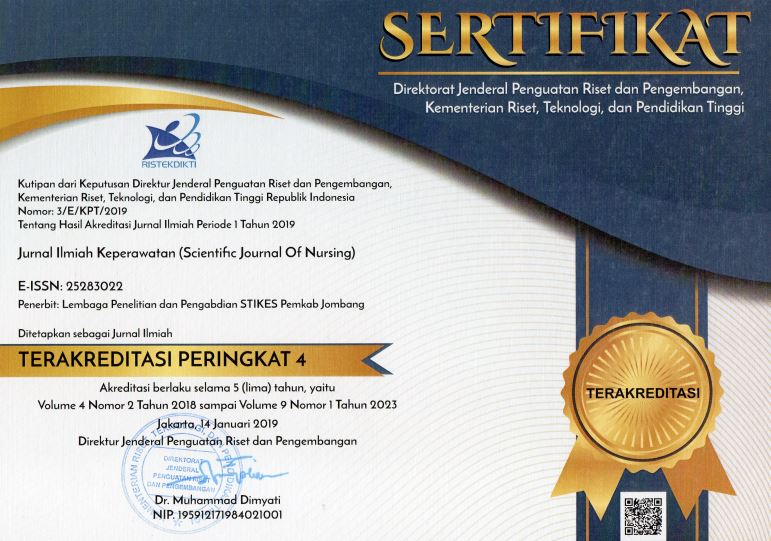FAKTOR-FAKTOR YANG BERHUBUNGAN DENGAN HIPERTENSI PADA REMAJA
Factors Related to Hypertension in Adolescents
DOI:
https://doi.org/10.33023/jikep.v9i5.1668Keywords:
hypertension, adolescents, factors of hypertensionAbstract
Abstrak
Pendahuluan :. Hipertensi remaja merupakan suatu masalah karena akan berlanjut pada usia dewasa dan memiliki risiko morbiditas dan mortalitas yang lebih tinggi.Upaya pemerintah dalam mengatasi hipertensi yaitu mengadakan program yang disebut CERDIK. Metode : Desain penelitian kuantitatif dengan metode cross-sectional. Sampel pada penelitian ini yaitu seluruh pelajar SMA Multazam IBS Semarang berjumlah 70 responden dengan teknik sampel yaitu total sampling. Data hasil penelitian dianalisis menggunakan uji chi square dan fisher exact. Hasil : Hasil penelitian menunjukkan tidak ada hubungan antara jenis kelamin (p = 1,000) dan riwayat hipertensi (p = 0,429) dengan hipertensi pada remaja. Serta terdapat hubungan antara IMT (p = 0,033), kualitas tidur (0,028), stress (0,039) dan aktivitas fisik (0,035) dengan hipertensi pada remaja. Simpulan : Terdapat hubungan antara IMT, kualitas tidur, stress dan aktivitas fisik dengan hipertensi pada remaja SMA Multazam IBS Semarang. Faktor-faktor risiko tersebut adalah hal yang dapat memicu tingginya tekanan darah dan menjadi risiko penyakit jantung dan stroke di masa depan. Meskipun awalnya seseorang tidak memiliki tekanan darah tinggi. Perlu adanya kerjasama dengan Puskesmas atau tenaga kesehatan supaya dapat skrining dan memantau tekanan darah siswa sebagai upaya deteksi hipertensi sejak dini.
Downloads
References
Azhim, A., Akioka, K., Akutagawa, M., Hirao, Y., Yoshizaki, K., Obara, S., … Kinouchi, Y. (2007). Effect of Gender on Blood Flow Velocities and Blood Pressure: Role of Body Weight and Height. 2007 29th Annual International Conference of the IEEE Engineering in Medicine and Biology Society, 967–970. https://doi.org/10.1109/IEMBS.2007.4352453
Batara, D., Bodhi, W., & Kepel, B. J. (2016). Hubungan obesitas dengan tekanan darah dan aktivitas fisik pada remaja di Kota Bitung. Jurnal E-Biomedik, 4(1), 0–5. https://doi.org/10.35790/ebm.4.1.2016.10842
Dinkes Jateng. (2018). Buku Profil Kesehatan Provinsi Jawa Tengah Tahun 2018. Dinas Kesehatan Jawa Tengah, 1–311.
Elvira, M., & Anggraini, N. (2019). Faktor-Faktor Yang Berhubungan Dengan Hipertensi. Jurnal Akademika Baiturrahim Jambi, 8(1), 78–89.
Gohil, A., & Hannon, T. S. (2018). Poor Sleep and Obesity: Concurrent Epidemics in Adolescent Youth. Frontiers in Endocrinology, 9. https://doi.org/10.3389/fendo.2018.00364
Kushkestani, M., Parvani, M., Ebrahimpour, S., Seyed, N., & Bathaeezadeh, Y. (2019). The Relationship between Body Composition with Blood Pressure and Sleep Quality in Male Dormitory Student at Allameh Tabataba’i University. New Approaches in Sport Sciences (NASS), 1(2), 77–92. https://doi.org/10.22054/nass.2019.10536
Li, Y., Gu, S., Wang, Z., Li, H., Xu, X., Zhu, H., … Huang, J. H. (2019). Relationship Between Stressful Life Events and Sleep Quality: Rumination as a Mediator and Resilience as a Moderator. Frontiers in Psychiatry, 10. https://doi.org/10.3389/fpsyt.2019.00348
Martini, S., Roshifanni, S., & Marzela, F. (2018). Pola Tidur yang Buruk Meningkatkan Risiko Hipertensi. Media Kesehatan Masyarakat Indonesia, 14(3), 297. https://doi.org/10.30597/mkmi.v14i3.4181
National Institutes of Health. (2005). Family history and high blood pressure. Natinal Heart, Lung and Blood Institude.
Patel, R. S., Masi, S., & Taddei, S. (2017). Understanding the role of genetics in hypertension. European Heart Journal, 38(29), 2309–2312. https://doi.org/10.1093/eurheartj/ehx273
Pescatello, L. S., Franklin, B. A., Fagard, R., Farquhar, W. B., Kelley, G. A., & Ray, C. A. (2004). Exercise and Hypertension. Medicine & Science in Sports & Exercise, 36(3), 533–553. https://doi.org/10.1249/01.MSS.0000115224.88514.3A
Rahmouni, K., Correia, M. L. G., Haynes, W. G., & Mark, A. L. (2005). Obesity-Associated Hypertension. Hypertension, 45(1), 9–14. https://doi.org/10.1161/01.HYP.0000151325.83008.b4
Ruiz, L. D., Zuelch, M. L., Dimitratos, S. M., & Scherr, R. E. (2019). Adolescent Obesity: Diet Quality, Psychosocial Health, and Cardiometabolic Risk Factors. Nutrients, 12(1), 43. https://doi.org/10.3390/nu12010043
Suryawan, Z. F. (2019). Analisis Faktor Yang Berhubungan Dengan Hipertensi Pada Remaja. Jurnal Keperawatan Muhammadiyah, 4(1). https://doi.org/10.30651/jkm.v4i1.2047
Tumanduk, W. M., Nelwan, J. E., & Asrifuddin, A. (2019). Faktor-faktor risiko hipertensi yang berperan di Rumah Sakit Robert Wolter Mongisidi. E-CliniC, 7(2). https://doi.org/10.35790/ecl.v7i2.26569
Zhang, N., Cao, B., & Zhu, Y. (2018). Indoor environment and sleep quality: A research based on online survey and field study. Building and Environment, 137, 198–207. https://doi.org/10.1016/j.buildenv.2018.04.007
Published
How to Cite
Issue
Section
Authors who publish with Jurnal Ilmiah Keperawatan (Scientific Journal of Nursing) agree to the following terms:
- Authors retain copyright and grant Jurnal Ilmiah Keperawatan (Scientific Journal of Nursing) the right of first publication with the work simultaneously licensed under a Creative Commons Attribution 4.0 International License that allows others to remix, adapt and build upon the work with an acknowledgment of the work's authorship and of the initial publication in Jurnal Ilmiah Keperawatan (Scientific Journal of Nursing).
- Authors are permitted to copy and redistribute the journal's published version of the work (e.g., post it to an institutional repository or publish it in a book), with an acknowledgment of its initial publication in Jurnal Ilmiah Keperawatan (Scientific Journal of Nursing).









